Coupling Relationship of Geomorphic Evolution and Marine Hydrodynamics in the Stage-Specific Development of Urban Bays: A Modelling Case Study in Quanzhou Bay (1954–2017), China
Abstract
:1. Introduction
2. Materials and Methods
2.1. Basic Data
2.1.1. Water Depth and Topographic Data
2.1.2. Hydrological Data
2.2. Hydrodynamic Model of Quanzhou Bay
2.2.1. Model Meshing and Parameter Setting
2.2.2. Water Exchange Capacity of the Bay
2.3. Changes in Land-Use Structure
3. Results
3.1. Validation of Model Accuracy
3.2. Variation of Exchange Intensity of Bay Water
3.3. Variation of Tidal Current Field
3.3.1. Change of Flow Field in Different Period
3.3.2. Variation of Current Velocity in Channel Area
4. Discussion
4.1. Effects of Human Activities on the Geomorphology and Hydrodynamic Evolution of the Bay
4.1.1. Influence of Sea Area Change on Exchange Capacity of Bay Waters
4.1.2. Variation of Current Velocity in Channel Area
4.2. The Stage Development of Urban Bay Hydrodynamics and Geomorphology Evolution
4.3. Future Urban Bay Development and Planning
5. Conclusions
Author Contributions
Funding
Institutional Review Board Statement
Informed Consent Statement
Data Availability Statement
Acknowledgments
Conflicts of Interest
References
- Liu, D.; Xu, Y.Y.; Faghihinia, M.; Kay, P.; Chan, F.K.S.; Wu, N. Evolving framework of studies on global gulf ecosystems with Sustainable Development Goals. Environ. Sci. Pollut. Res. 2022, 29, 18385–18397. [Google Scholar] [CrossRef] [PubMed]
- Day, J.W.; Gunn, J.D.; Burger, J.R. Diminishing opportunities for sustainability of coastal cities in the Anthropocene, a review. Front. Environ. Sci. 2021, 9, 663275. [Google Scholar] [CrossRef]
- Li, P.H.; Zhao, C.; Liu, K.; Xiao, X.T.; Wang, Y.J.; Wang, Y.T.; He, D. Anthropogenic influences on dissolved organic matter in three coastal bays, North China. Front. Earth. Sci. 2021, 9, 575. [Google Scholar] [CrossRef]
- Wu, Z.Y.; Milliman, J.D.; Zhao, D.N.; Zhou, J.Q.; Yao, C.H. Recent geomorphic change in LingDing Bay, China, in response to economic and urban growth on the Pearl River Delta, Southern China. Glob. Planet. Chang. 2014, 123, 1–12. [Google Scholar] [CrossRef]
- Shadrin, N.V. Coupling of Shoreline Erosion and Biodiversity Loss, Examples from the Black Sea. Int. J. Mar. Sci. 2013, 3, 43. [Google Scholar] [CrossRef] [Green Version]
- Li, J.L.; Pu, R.L.; Yuan, Q.X.; Liu, Y.C.; Feng, B.X.; Guo, Q.D. Spatiotemporal change patterns of coastlines in Xiangshan Harbor (Zhejiang, China) during the past 40 years. J. Coast. Res. 2018, 34, 1418–1428. [Google Scholar] [CrossRef]
- Yang, C.; Li, Q.Q.; Hu, Z.W.; Chen, J.Y.; Shi, T.Z.; Ding, K.; Wu, G.F. Spatiotemporal evolution of urban agglomerations in four major bay areas of US, China and Japan from 1987 to 2017, evidence from remote sensing images. Sci. Total Environ. 2019, 671, 232–247. [Google Scholar] [CrossRef]
- Escudero, M.; Silva, R.; Mendoza, E. Beach Erosion Driven by Natural and Human Activity at Isla del Carmen Barrier Island, Mexico. J. Coast. Res. 2014, 71, 62–74. [Google Scholar] [CrossRef]
- Yin, Y.; Jiang, L.F.; Zhang, Z.X.; Yu, H.B. Hydrodynamic changes due to coastal reclamation activities in Daya Bay. Aquat. Ecosyst. Health 2019, 22, 215–227. [Google Scholar] [CrossRef]
- Lin, S.C.; Liu, G.P.; Niu, J.W.; Wei, X.; Cai, S.Q. Responses of hydrodynamics to changes in shoreline and bathymetry in the Pearl River Estuary, China. Cont. Shelf. Res. 2021, 229, 104556. [Google Scholar] [CrossRef]
- Gallerano, F.; Cannata, G.; Scarpone, S. Bottom changes in coastal areas with complex shorelines. Eng. Appl. Comput. Fluid Mech. 2017, 11, 396–416. [Google Scholar] [CrossRef]
- Yan, X.L.; Hu, Y.M.; Chang, Y.; Zhang, D.H.; Liu, M.; Guo, J.T.; Ren, B.H. Monitoring wetland changes both outside and inside reclamation areas for coastal management of the Northern Liaodong Bay, China. Wetlands 2017, 37, 885–897. [Google Scholar] [CrossRef]
- De Muro, S.; Porta, M.; Pusceddu, N.; Frongia, P.; Passarella, M.; Ruju, A.; Buosi, C.; Ibba, A. Geomorphological processes of a Mediterranean urbanized beach (Sardinia, Gulf of Cagliari). J. Maps. 2018, 14, 114–122. [Google Scholar] [CrossRef] [Green Version]
- Leonardo, H.N.N.; Noel, C.; Yovani, M.L. Bedload Transport of Sediments and Morphodynamics in the Northern Gulf of California. J. Coast. Res. 2014, 30, 228–236. [Google Scholar] [CrossRef]
- Jia, R.; Lei, H.Y.; Hino, T.; Arulrajah, A. Environmental changes in Ariake Sea of Japan and their relationships with Isahaya Bay reclamation. Mar. Pollut. Bull. 2018, 135, 832–844. [Google Scholar] [CrossRef]
- Xiao, X.B.; Li, Y.H.; Shu, F.F.; Wang, L.; He, J.; Zou, X.C.; Chi, W.Q.; Lin, Y.T.; Zheng, B.X. Coupling relationship of human activity and geographical environment in stage-specific development of urban coastal zone: A case study of Quanzhou Bay, China (1954–2020). Front. Mar. Sci. 2022, 8, 781910. [Google Scholar] [CrossRef]
- Liu, C.L.; Chang, J.; Chen, M.J.; Zhang, T. Dynamic monitoring and its influencing factors analysis of coastline in the Laizhou Bay since 1985. J. Coast. Res. 2020, 105, 18–22. [Google Scholar] [CrossRef]
- Lin, Y.P. The Material “Source and Sink” Process of Quanzhou Bay under the Impact of Typhoon Matmo (2014); Academic Thesis of Third Institute of Oceanography: Xiamen, China, 2020; (In Chinese with English Abstract). [Google Scholar] [CrossRef]
- Liu, X. Study on the Marine sed i Mentary Env Ironment Evolution of the Southern of Laizhou Bay under the Impact or Port Projects; Ocean University of China: Qingdao, China, 2014; (In Chinese with English Abstract). [Google Scholar]
- Arasteh, A.M.; Dastdaran, M.; Morovvati, H.; Azad, M.T.; Lari, K. Investigation of the two-dimensional model of water flow in the Gorgan Bay under the influence of various hydrodynamic factors using Mike 21 software. Ukr. J. Ecol. 2017, 7, 366–373. [Google Scholar] [CrossRef]
- Ji, H.D.; Pan, W.R.; Zhang, G.R.; Luo, Z.B. The calculation of volume of tidal prism and water exchange time of Yundang Lake. J. Xiamen Univ. (Nat. Sci.) 2006, 5, 660–663, (In Chinese with English Abstract). [Google Scholar]
- Ma, Q.X. A Study on Relation between the Level of Urbanization and the Changes of Land Utilization in Jinjiang City; Fujian Normal University: Fuzhou, China, 2013; (In Chinese with English Abstract). [Google Scholar]
- Management of Waterway Transportation Information System. Available online: https://mwtis.mot.gov.cn/syportal/sybz (accessed on 10 May 2022).
- Kai, X.; Li, H.; Song, D.; Chen, Y.; Huang, Y. Field measurements for investigating the dynamics of the tidal prism during a spring-neap tidal cycle in Jiaozhou bay, China. J. Coast. Res. 2018, 35, 335–347. [Google Scholar] [CrossRef]
- Yu, R.L.; Zhang, W.F.; Hu, G.R.; Lin, C.Q.; Yang, Q.L. Heavy metal pollution and Pb isotopic tracing in the intertidal surface sediments of Quanzhou Bay, southeast coast of China. Mar. Pollut. Bull. 2016, 105, 416–421. [Google Scholar] [CrossRef] [PubMed]
- Homira, A. Ecological risk assessment of heavy metals in sediment, fish, and human hair from Chabahar Bay, Makoran, Iran. Mar. Pollut. Bull. 2021, 169, 112345. [Google Scholar] [CrossRef]
- Wang, C.; Sun, Q.; Jiang, S.; Wang, J.K. Evaluation of pollution source of the bays in Fujian Province. Procedia Environ. Sci. 2011, 10, 685–690. [Google Scholar] [CrossRef] [Green Version]
- Chen, B.H.; Wang, K.; Dong, X.; Lin, H. Long-term changes in red tide outbreaks in Xiamen Bay in China from 1986 to 2017. Estuar. Coast. Shelf Sci. 2021, 249, 107095. [Google Scholar] [CrossRef]
- Azab, I.; Cdb, C.; Jv, D.; Vme, F.; Gi, B.; Asp, G.; Ac, H. Benthic microbial diversity trends in response to heavy metals in an oxygen-deficient eutrophic bay of the Humboldt current system offshore the Atacama Desert. Environ. Pollut. 2021, 286, 117281. [Google Scholar] [CrossRef]
- Dong, J.Y.; Zhao, L.L.; Sun, X.; Hu, C.Y.; Wang, Y.H.; Li, W.T.; Zhang, P.D.; Zhang, X.M. Response of macrobenthic communities to heavy metal pollution in Laoshan Bay, China, A trait-based method. Mar. Pollut. Bull. 2021, 167, 112292. [Google Scholar] [CrossRef]
- Alexa, L.; Arnaud, H.; Amandine, N.; Nicolas, P. Influence of shoreface morphological changes since the 19th century on nearshore hydrodynamics and shoreline evolution in Wissant Bay (northern France). Mar. Geol. 2020, 422, 106095. [Google Scholar] [CrossRef]
- Tefa, B.; Vca, B.; Slgc, D.; Rsa, B.; Vdse, F.; Jllg, H. Decadal shoreline erosion and recovery of beaches in modified and natural estuaries. Geomorphology 2021, 390, 107884. [Google Scholar] [CrossRef]
- Kuang, C.; He, L.; Gu, J.; Pan, Y.; Zhang, Y.; Yang, Y.; Qiu, R.; Zhang, J.B. Effects of submerged breakwater on hydrodynamics and shoreline change of the East Beach of Beidaihe, Bohai Bay, China. J. Coast. Res. 2014, 30, 598–614. [Google Scholar] [CrossRef]
- Masria, A.A.; Negm, A.M.; Iskander, M.M.; Saavedra, O.C. Hydrodynamic modeling of outlet stability case study Rosetta promontory in Nile delta. Water Sci. 2013, 27, 39–47. [Google Scholar] [CrossRef]
- Zhou, Y.; Ye, Q.; Shi, W.Y.; Yang, B.; Song, Z.K.; Yan, D.L. Wave characteristics in the nearshore waters of Sanmen Bay. Appl. Ocean Res. 2020, 101, 102236. [Google Scholar] [CrossRef]
- Zarzuelo, C.; Ruiz, A.L.; Sánchez, M.O. The role of waves and heat exchange in the hydrodynamics of multi-basin bays: The example of Cádiz Bay (Southern Spain). J. Geophys. Res. Ocean 2021, 126, e2020JC016346. [Google Scholar] [CrossRef]
- Liu, H.; Kang, H.X.; Yin, B.S. Sediment transport in the Quanzhou Bay. Adv. Mater. Res. 2014, 2914, 2388–2391. [Google Scholar] [CrossRef]
- Wang, A.J. Hydrodynamics and associated sediment transport over coastal wetlands in Quanzhou Bay, China. China Ocean Eng. 2011, 25, 59–72. [Google Scholar] [CrossRef]
- Sickbert, T.; Peterson, E.W. The effects of surface water velocity on hyporheic interchange. J. Water Resour. Prot. 2014, 6, 327–336. [Google Scholar] [CrossRef] [Green Version]
- He, Z.X.; Jia, L.W.; Jia, Y.H.; He, J.W. Effects of flood events on sediment transport and deposition in the waterways of Lingding Bay, Pearl River Delta, China. Ocean Coast. Manag. 2020, 185, 105062. [Google Scholar] [CrossRef]
- Shen, Y.M.; Zhang, H.X.; Tang, J. Hydrodynamics and water quality impacts of large-scale reclamation projects in the Pearl River Estuary. Ocean. Eng. 2022, 257, 111432. [Google Scholar] [CrossRef]
- Liu, C.j.; Zhong, Z.Y.; Xiao, Y.Q.; Chen, X.Q.; Yu, M.H. Impacts of Human Activities on Hydrodynamic Structures during the dry season in the Modaomen Estuary. J. Mar. Sci. Eng. 2021, 9, 1327. [Google Scholar] [CrossRef]
- China Dredging Association. Available online: http://www.chida.org/ (accessed on 10 August 2022).
- Yang, L.; Liu, F.; Gong, W.; Cai, H.; Yu, F.; Pan, H. Morphological response of Lingding Bay in the Pearl River Estuary to human intervention in recent decades. Ocean Coast. Manag. 2019, 176, 1–10. [Google Scholar] [CrossRef]
- Ilinskas, G.; Januait, R.; Jarmalaviius, D.; Pupienis, D. The impact of Klaipėda Port entrance channel dredging on the dynamics of coastal zone, Lithuania. Oceanologia 2020, 64, 489–500. [Google Scholar] [CrossRef]
- Cheng, J.Y.; Wang, X.M.; Kong, L.N.; Li, Y.X.; Han, J.B.; Zhang, X.X. Source apportionment and specific risk assessment of heavy metals in sediment, Application to the Typical Bay, China. Reg. Stud. Mar. Sci. 2020, 54, 102452. [Google Scholar] [CrossRef]
- Zeng, L.; Jiang, S.; Jing, L.H.; Xue, Y. Source Apportionment of heavy metal contamination in urban-agricultural-aquacultural soils near the Bohai Bay Coast, using land-use classification and google satellite tracing. Remote Sens. 2022, 14, 2436. [Google Scholar] [CrossRef]
- Rey-Martínez, N.; Guisasola, A.; Baeza, J.A. Assessment of the significance of heavy metals, pesticides and other contaminants in recovered products from water resource recovery facilities. Resour. Conserv. Recycl. 2022, 182, 106313. [Google Scholar] [CrossRef]
- Yu, C.; Sui, W.; Liang, B.; Bao, C.; Ma, M. Temporal trends of heavy metals in the sediments of Bohai Bay in China. Environ. Monit. Assess. 2022, 194, 79. [Google Scholar] [CrossRef]
- Yan, X.X.; An, J.; Yin, Y.C.; Gao, C.C.; Wang, B.Y.; Wei, S.H. Heavy metals uptake and translocation of typical wetland plants and their ecological effects on the coastal soil of a contaminated bay in Northeast China. Sci. Total Environ. 2022, 803, 149871. [Google Scholar] [CrossRef]
- Wen, Y.; Kamranzad, B.; Lin, P. Joint exploitation potential of offshore wind and wave energy along the south and southeast coasts of China. Energy 2022, 249, 123710. [Google Scholar] [CrossRef]
- Hu, S.L. A Study on Land Reclamation and Its Management Systems; Ocean University of China: Qingdao, China, 2011; (In Chinese with English Abstract). [Google Scholar]
- Nogués, S.; Arroyo, N.L. Alternative approach to prioritization of Brownfield reclamation attending to urban development potentialities, Case study in a depressed industrial district in Northern Spain. J. Urban. Plan. Dev. 2015, 142, 1–18. [Google Scholar] [CrossRef]
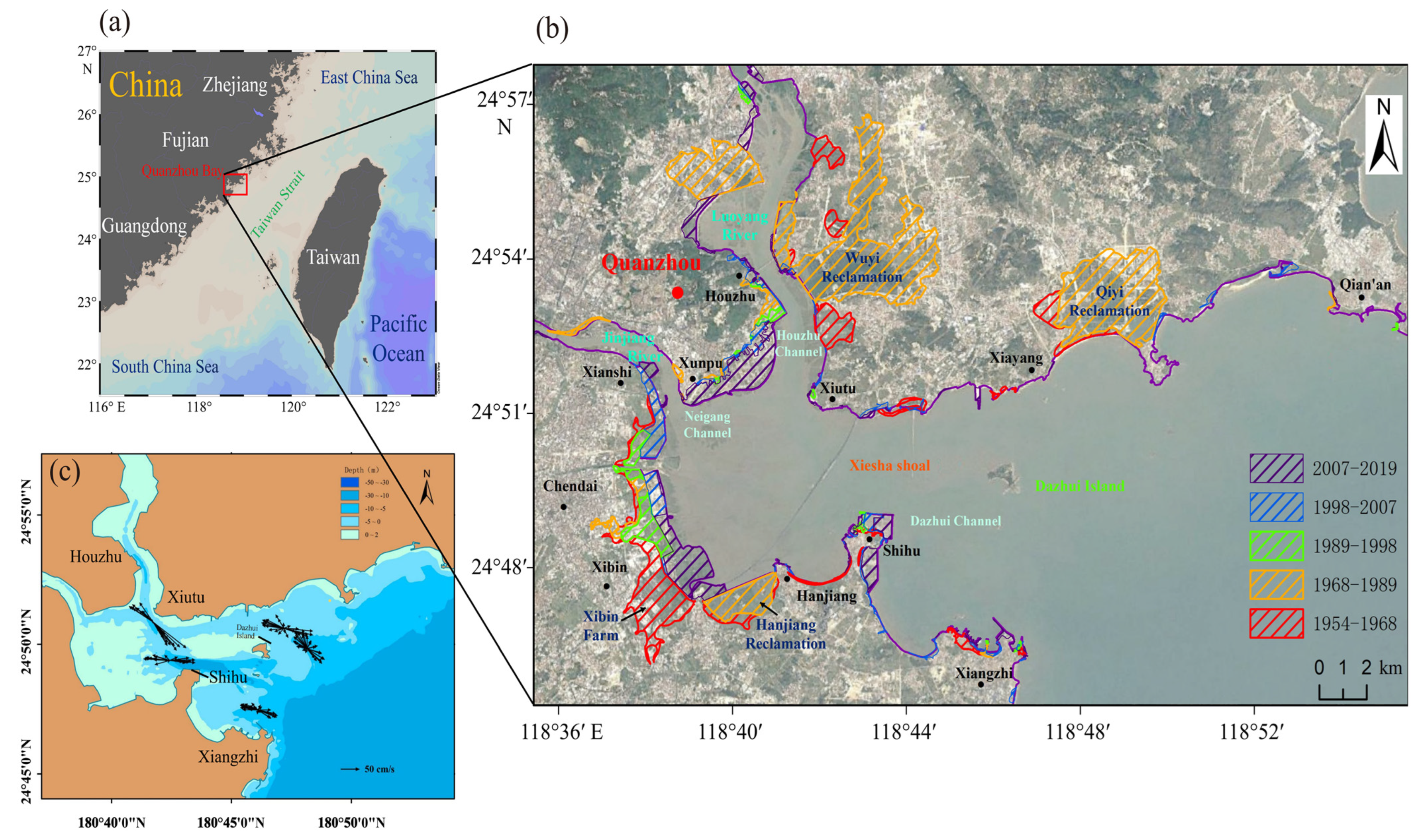
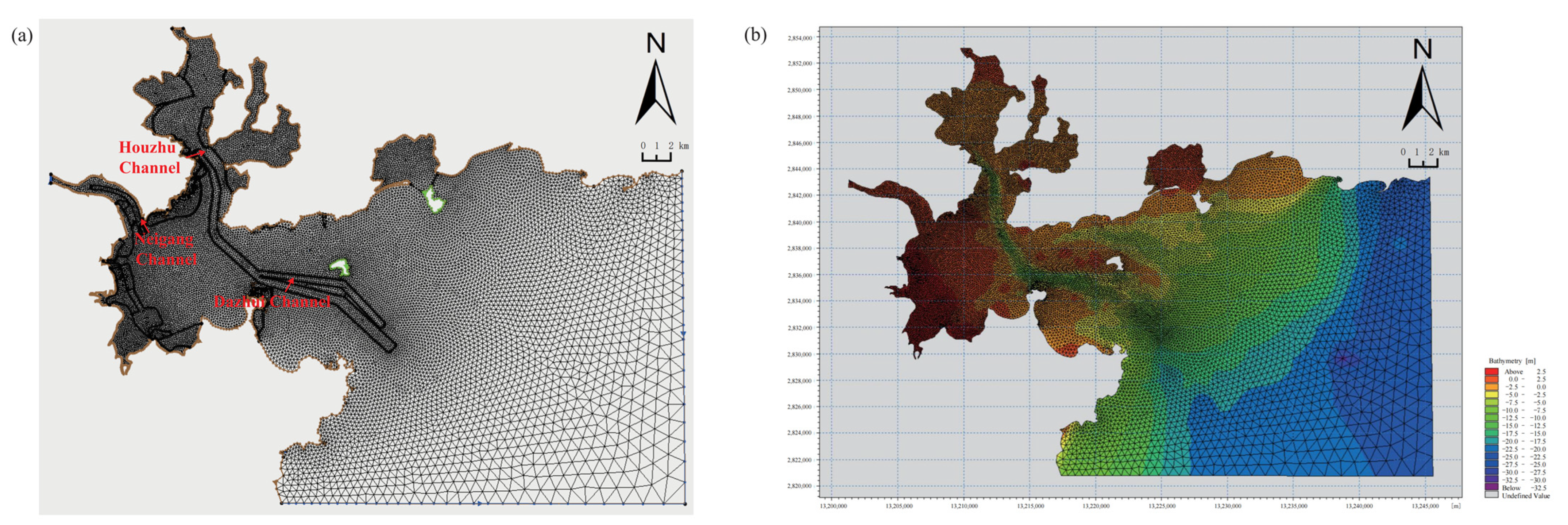
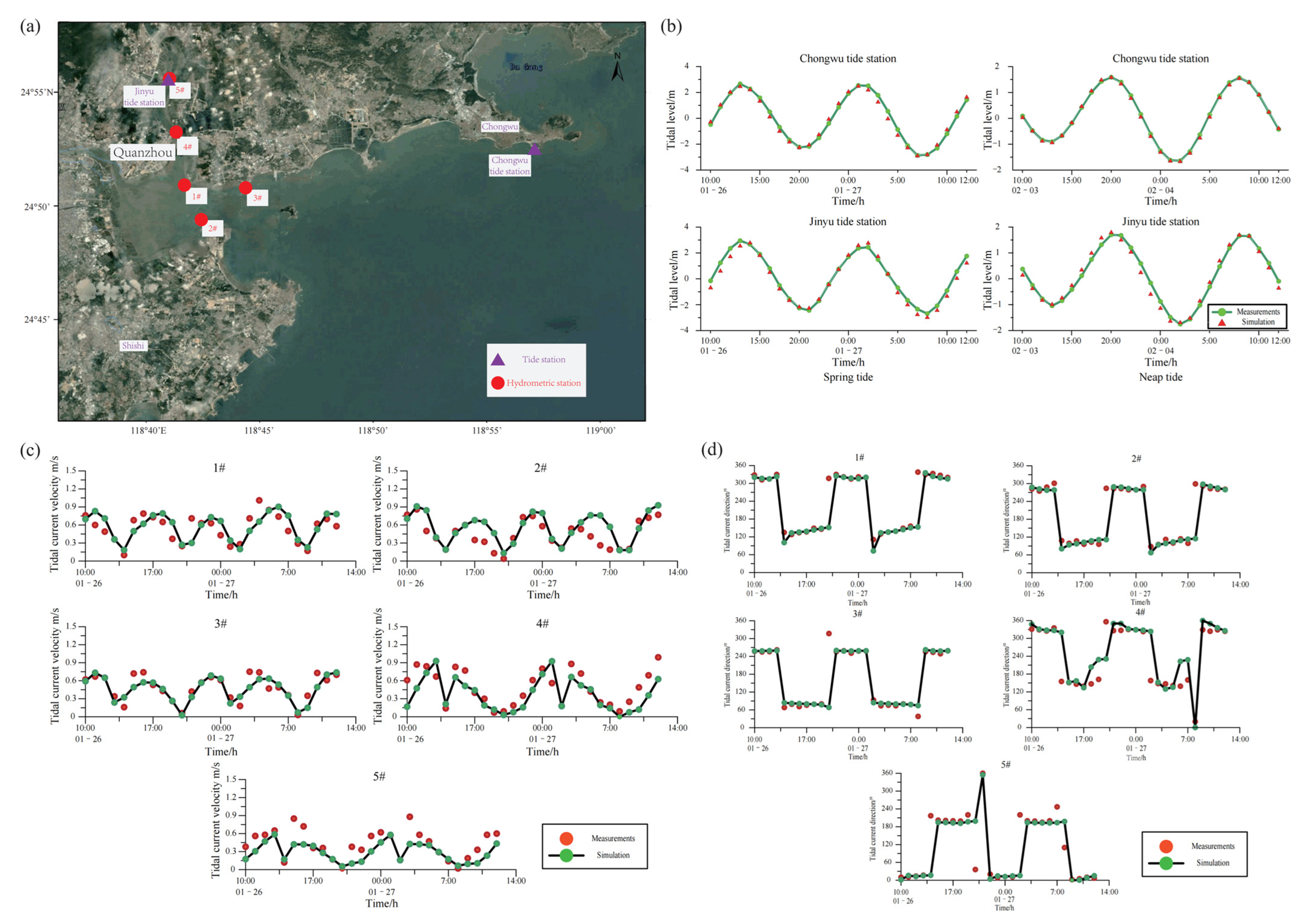
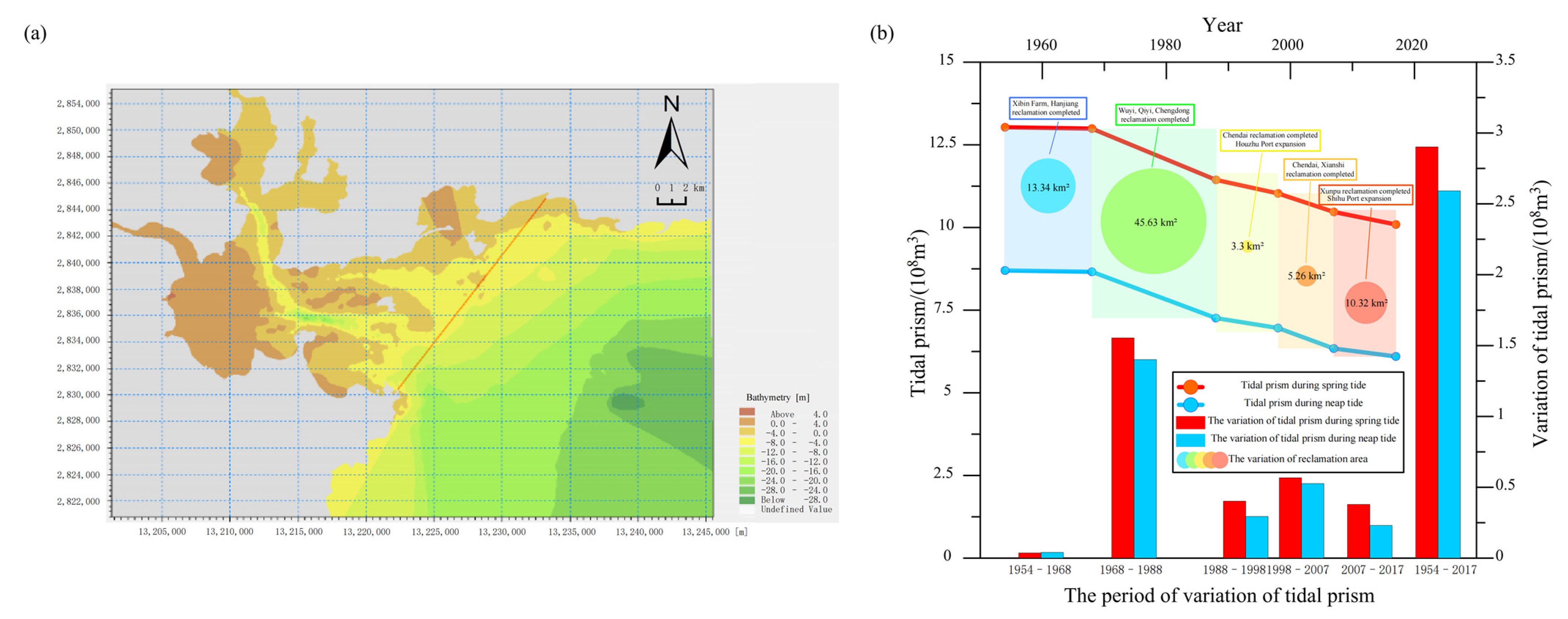

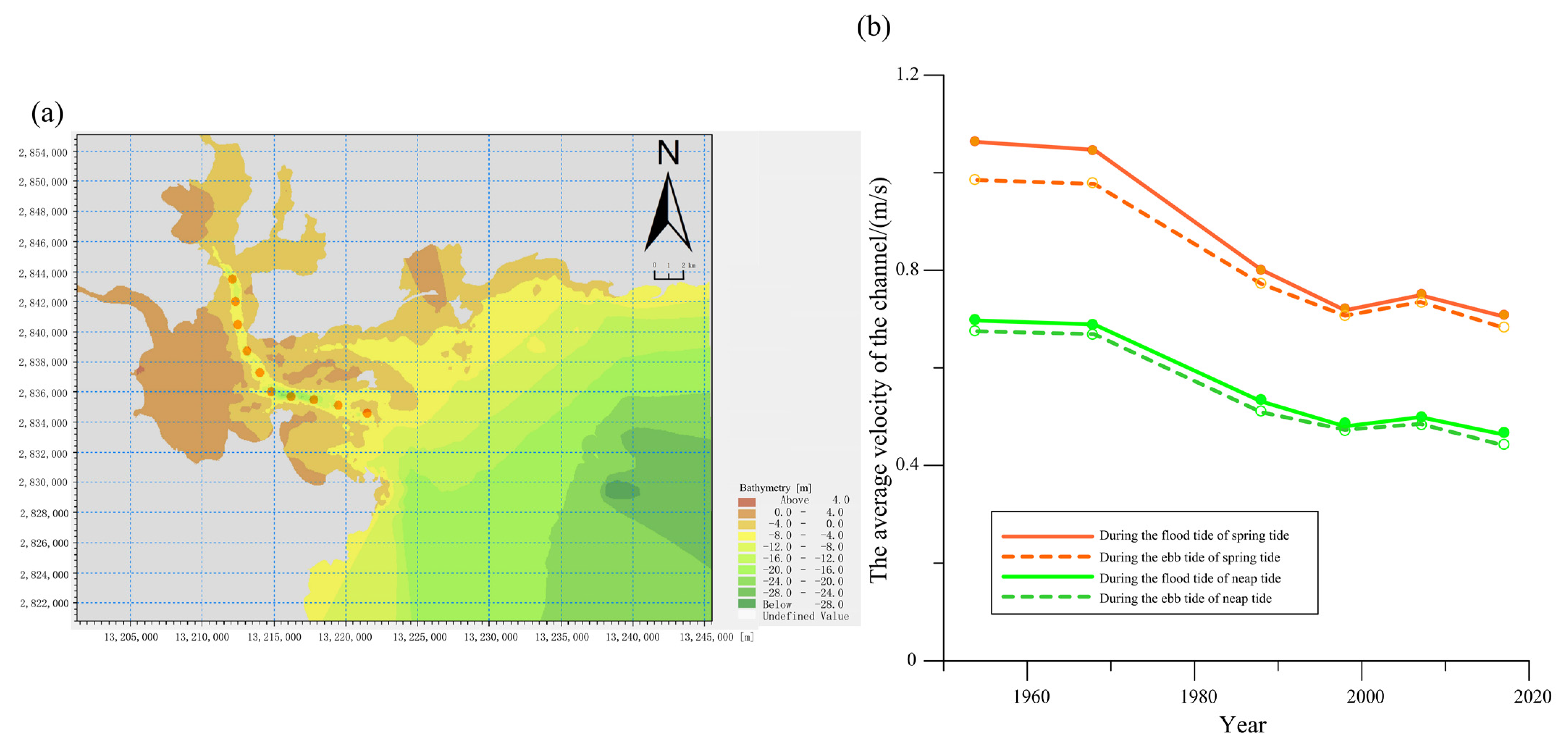

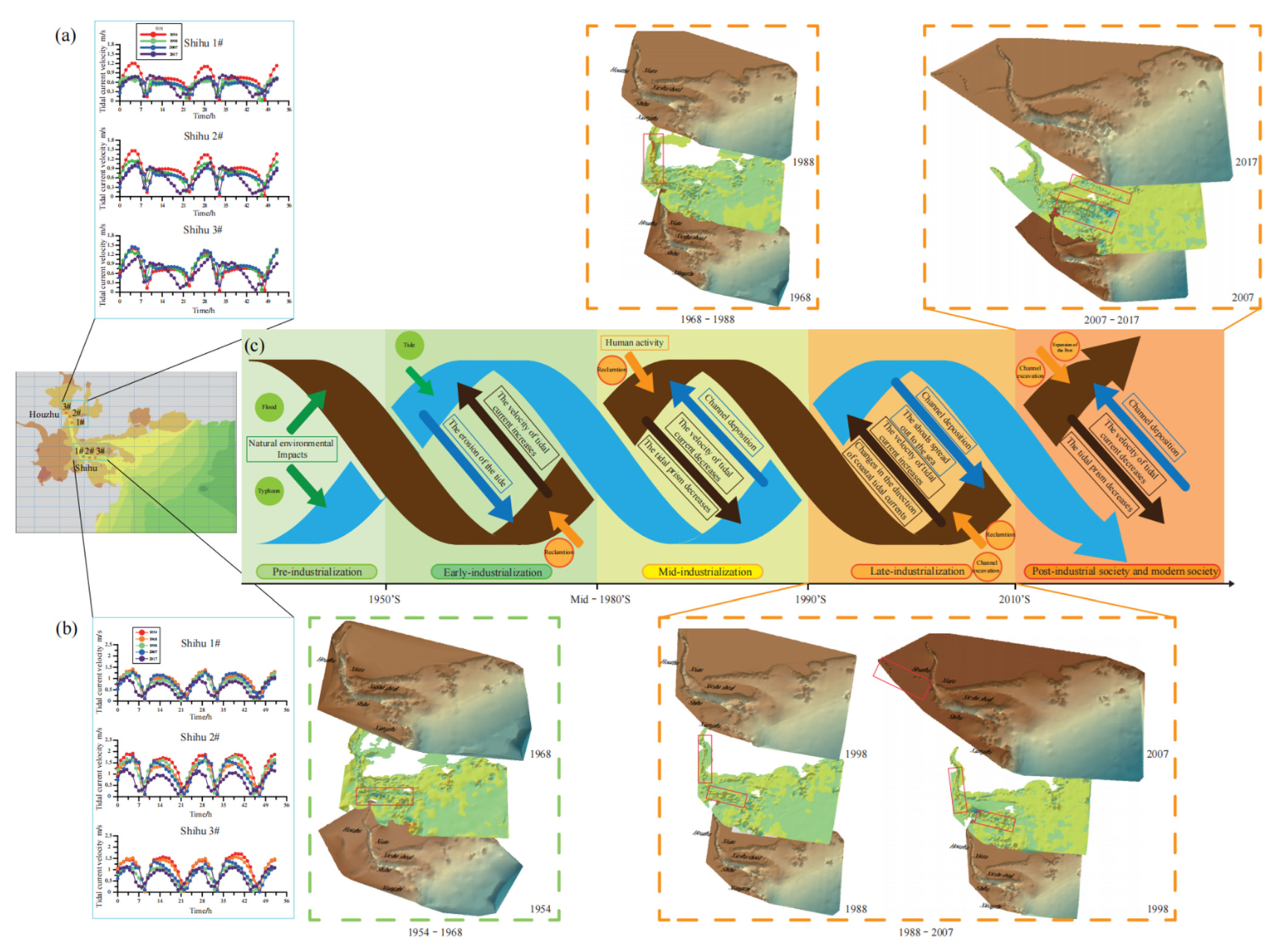
| Marine Map Name | Marine Map Number | Scale | Coordinate System | Time of Publication |
|---|---|---|---|---|
| Nanri Island to Quanzhou Bay | 10–56 | 1:100,000 | - | April 1973 |
| Quanzhou Bay | 5616 | 1:50,000 | Beijing54 | September 1975 |
| Quanzhou Bay | 14,181 | 1:35,000 | Beijing54 | April 2000 |
| Quanzhou Bay | 14,181 | 1:35,000 | Beijing54 | April 2003 |
| Quanzhou Bay | 14,181 | 1:35,000 | WGS84 | May 2008 |
| Quanzhou Bay | 14,181 | 1:35,000 | CGCS2000 | July 2019 |
| Measure Time | Measuring Area | ||
|---|---|---|---|
| Neigang Channel | Dazhui Channel | Houzhu Channel | |
| 2013 | Up to the junction of Neigang channel and Houzhu channel, down to the downstream of Quanzhou Bridge. The measuring area is about 4.2 km2. | Outside to the southern part of the Dazhui island, inside to the junction of the Shihu channel and the Dazhui island channel. The measuring area is about 3.59 km2. | From the Dazhui island to the Houzhu Port. |
| 2015 | Up to the Quanzhou Bridge and down to the junction of Neigang channel and Houzhu channel. | From the anchorage outside Quanzhou Bay, follow the Dazhui island channel to the ports of Shihu and Xiutu. The measuring length was 11.04 km. | It is about 8.8 km from Shihu to Houzhu. |
| 2017 | / | From the anchorage outside Quanzhou Bay, follow the Dazhui island channel to the ports of Shihu and Xiutu. The measuring length was 11.04 km. | It is about 8.8 km from Shihu to Houzhu. |
| Calculation of Tidal Level Error | ||||||||||
| Time | Chongwu Tide Station | Jinyu Tide Station | Time | Chongwu Tide Station | Jinyu Tide Station | |||||
| 2016/1/26 13:00 | 0.08 | 0.29 | 2016/2/3 13:00 | 0.01 | 0.08 | |||||
| 2016/1/26 19:00 | 0.09 | 0.02 | 2016/2/3 19:00 | 0.01 | 0.11 | |||||
| 2016/1/27 1:00 | 0.09 | 0.17 | 2016/2/4 2:00 | 0.01 | 0.09 | |||||
| 2016/1/27 8:00 | 0.18 | 0.11 | 2016/2/4 8:00 | 0 | 0.05 | |||||
| Calculation of Tidal Current Error | ||||||||||
| Time | 1# | 2# | 3# | 4# | 5# | |||||
| Spring tide Mean tidal current velocity | Flood | 0.09 | 0.01 | 0.02 | 0.17 | 0.16 | ||||
| Ebb | 0.09 | 0.10 | 0.03 | 0.04 | 0.01 | |||||
| Flood | 0.06 | 0.01 | 0.08 | 0.05 | 0.19 | |||||
| Ebb | 0.19 | 0.22 | 0.03 | 0.08 | 0.12 | |||||
| Flood | 0.00 | 0.01 | 0.03 | 0.12 | 0.14 | |||||
| Ebb | 0.13 | 0.08 | 0.03 | 0.09 | 0.00 | |||||
| Flood | 0.03 | 0.04 | 0.01 | 0.11 | 0.23 | |||||
| Ebb | 0.17 | 0.18 | 0.07 | 0.10 | 0.10 | |||||
| Flood | 0.02 | 0.03 | 0.03 | 0.27 | 0.16 | |||||
| Calculation of Tidal Current Direction Error | ||||||||||
| Time | 1# | 2# | 3# | 4# | 5# | |||||
| Spring tide | 2016/1/26 10:00 | 7.7 | 5.5 | 0.9 | 16.6 | 8.6 | ||||
| 2016/1/26 11:00 | 4.7 | 6.9 | 3.4 | 2.1 | 4.9 | |||||
| 2016/1/26 12:00 | 0.1 | 10.3 | 3.4 | 2.6 | 1.5 | |||||
| 2016/1/26 13:00 | 7.0 | 22.6 | 2.4 | 8.2 | 1.6 | |||||
| 2016/1/26 14:00 | 34.3 | 27.3 | 16.0 | 165.2 | 200.3 | |||||
| 2016/1/26 15:00 | 5.6 | 5.2 | 3.0 | 0.9 | 7.1 | |||||
| 2016/1/26 16:00 | 2.0 | 9.4 | 10.2 | 10.8 | 6.8 | |||||
| 2016/1/26 17:00 | 1.6 | 6.6 | 4.0 | 4.7 | 7.2 | |||||
| 2016/1/26 18:00 | 5.9 | 4.5 | 0.1 | 56.5 | 7.4 | |||||
| 2016/1/26 19:00 | 2.6 | 15.1 | 2.6 | 66.7 | 23.1 | |||||
| 2016/1/26 20:00 | 165.2 | 172.6 | 248.8 | 125.2 | 163.0 | |||||
| 2016/1/26 21:00 | 5.0 | 5.8 | 3.9 | 24.1 | 5.3 | |||||
| 2016/1/26 22:00 | 1.3 | 5.1 | 1.1 | 23.0 | 16.0 | |||||
| 2016/1/26 23:00 | 2.7 | 4.4 | 7.1 | 2.1 | 5.4 | |||||
| 2016/1/27 0:00 | 6.4 | 0.1 | 0.8 | 0.1 | 0.2 | |||||
| 2016/1/27 1:00 | 0.4 | 10.9 | 1.0 | 4.6 | 3.5 | |||||
| 2016/1/27 2:00 | 38.2 | 20.3 | 8.6 | 165.4 | 204.3 | |||||
| 2016/1/27 3:00 | 3.6 | 0.9 | 8.0 | 4.1 | 5.7 | |||||
| 2016/1/27 4:00 | 0.2 | 13.5 | 4.9 | 17.3 | 5.6 | |||||
| 2016/1/27 5:00 | 0.3 | 3.6 | 5.8 | 5.5 | 2.0 | |||||
| 2016/1/27 6:00 | 4.5 | 5.5 | 1.0 | 83.7 | 7.2 | |||||
| 2016/1/27 7:00 | 5.5 | 13.9 | 0.0 | 68.1 | 53.2 | |||||
| 2016/1/27 8:00 | 184.8 | 184.2 | 36.4 | 20.0 | 87.8 | |||||
| 2016/1/27 9:00 | 5.4 | 6.0 | 6.2 | 31.0 | 2.1 | |||||
| 2016/1/27 10:00 | 9.3 | 7.5 | 4.6 | 25.7 | 5.4 | |||||
| 2016/1/27 11:00 | 8.3 | 4.2 | 8.9 | 6.7 | 1.9 | |||||
| 2016/1/27 12:00 | 4.8 | 1.3 | 0.2 | 1.7 | 8.0 | |||||
| Year | Cities and Industries (m2) | Agriculture (m2) | Port (m2) | Aquaculture (m2) | Other Types of Land (m2) | Total Area for Reclamation (m2) | Landscape Indices |
|---|---|---|---|---|---|---|---|
| 1972 | 5.64 | 6.71 | 0 | 1.01 | 0.23 | 13.588 | 0.976 |
| 1988 | 12.6 | 39.1 | 0.80 | 1.39 | 2.74 | 56.628 | 0.888 |
| 1995 | 17.95 | 33.75 | 1.29 | 4.20 | 3.00 | 60.188 | 1.103 |
| 2006 | 27.21 | 25.82 | 2.22 | 7.06 | 4.07 | 66.378 | 1.256 |
| 2019 | 41.02 | 22.61 | 3.69 | 5.56 | 6.09 | 78.968 | 1.226 |
Publisher’s Note: MDPI stays neutral with regard to jurisdictional claims in published maps and institutional affiliations. |
© 2022 by the authors. Licensee MDPI, Basel, Switzerland. This article is an open access article distributed under the terms and conditions of the Creative Commons Attribution (CC BY) license (https://creativecommons.org/licenses/by/4.0/).
Share and Cite
Xiao, X.; Li, Y.; Tang, J.; Luo, F.; Shu, F.; Wang, L.; He, J.; Zou, X.; Chi, W.; Lin, Y.; et al. Coupling Relationship of Geomorphic Evolution and Marine Hydrodynamics in the Stage-Specific Development of Urban Bays: A Modelling Case Study in Quanzhou Bay (1954–2017), China. J. Mar. Sci. Eng. 2022, 10, 1677. https://doi.org/10.3390/jmse10111677
Xiao X, Li Y, Tang J, Luo F, Shu F, Wang L, He J, Zou X, Chi W, Lin Y, et al. Coupling Relationship of Geomorphic Evolution and Marine Hydrodynamics in the Stage-Specific Development of Urban Bays: A Modelling Case Study in Quanzhou Bay (1954–2017), China. Journal of Marine Science and Engineering. 2022; 10(11):1677. https://doi.org/10.3390/jmse10111677
Chicago/Turabian StyleXiao, Xianbiao, Yunhai Li, Junjian Tang, Fusheng Luo, Fangfang Shu, Liang Wang, Jia He, Xiaochun Zou, Wenqi Chi, Yuting Lin, and et al. 2022. "Coupling Relationship of Geomorphic Evolution and Marine Hydrodynamics in the Stage-Specific Development of Urban Bays: A Modelling Case Study in Quanzhou Bay (1954–2017), China" Journal of Marine Science and Engineering 10, no. 11: 1677. https://doi.org/10.3390/jmse10111677
APA StyleXiao, X., Li, Y., Tang, J., Luo, F., Shu, F., Wang, L., He, J., Zou, X., Chi, W., Lin, Y., & Zheng, B. (2022). Coupling Relationship of Geomorphic Evolution and Marine Hydrodynamics in the Stage-Specific Development of Urban Bays: A Modelling Case Study in Quanzhou Bay (1954–2017), China. Journal of Marine Science and Engineering, 10(11), 1677. https://doi.org/10.3390/jmse10111677







